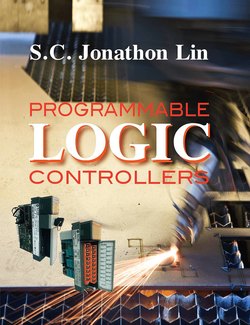Читать книгу Programmable Logic Controllers - Su Chen Jonathon Lin - Страница 13
На сайте Литреса книга снята с продажи.
ОглавлениеCHAPTER 5
Simplifying Logic Circuits
Objectives: Understand Boolean algebra postulates and laws.
List reasons for simplifying logic circuits.
Apply Boolean algebra laws to simplify logic circuits.
Explain the principles of Karnaugh maps.
Construct 2-variable Karnaugh maps.
Describe how to use Boolean inverter OR logic to simplify logic terms in Karnaugh maps.
Apply the Karnaugh map method to simplify logic circuits.
Construct 3-variable and 4-variable Karnaugh maps.
Overview
Most logic circuits should be developed in their simplest forms in order to (1) reduce the amount of wiring and the number of components if hard-wired relay ladder circuits are used and (2) shorten the scanning cycle time in PLC applications. Additional benefits include a reduced number of hard-wired connections, reduced cost of the product, and, finally, a reduction in errors because the circuit is simpler.
Two common methods used to simplify logic equations using logic equations are Boolean laws and Karnaugh maps. This chapter explains these two logic circuit simplification methods in detail. The chapter starts with Boolean algebra postulates and laws, followed by tips for using Boolean algebra laws successfully. The second half of the chapter is devoted to the construction of Karnaugh maps, and applying the simplification principle of Karnaugh maps.
5.1 Boolean Algebra Postulates
Boolean equations can be manipulated and simplified using various Boolean algebra postulates and laws. There are three postulates used in Boolean algebra operations.
5.1.1Postulate 1
If A is not 1, then A shall be 0; and if A is not 0, then A has the value of 1.
If A ≠ 1, then A = 0
If A ≠ 0, then A = 1
5.1.2Postulate 2
The result of the OR logic with a 0 or 1 follows the rules shown in Table 5.1.
5.1.3Postulate 3
The result of the AND logic with a 0 or a 1 follows the rules shown in Table 5.2.
Table 5.1: OR Logic with a 0 or a 1
Table 5.2: AND Logic with a 0 or a 1
5.2 Boolean Algebra Laws
There are a number of Boolean algebra laws that can be used to simplify the Boolean equations that represent logic circuits. Table 5.3 illustrates seven common Boolean algebra laws.
Table 5.3: Boolean algebra laws
5.2.1Commutative Laws
Commutative laws state that the order of two or more elements are commutative when they have either an AND or an OR relationship. This means that the order of two AND or OR elements does not change the output result. Figure 5.1 shows the commutative AND function of three elements A, B, and C. Figure 5.2 illustrates the commutative OR function of three elements A, B, and C.
Figure 5.1: Commutative AND function
Figure 5.2: Commutative OR function
5.2.2Associative Laws
Associative laws indicate that the grouping of elements can change without changing the result, provided that all of the operations between elements are the same relationship, either all ANDs or ORs. This means that the order of the AND or OR elements does not change the output result (Figure 5.3 and Figure 5.4).
Figure 5.3: Associative OR function
Figure 5.4: Associative AND function
5.2.3Distributive Laws
The distributive laws allow us to rearrange elements in combinations of AND and OR relationships. Often by rearranging elements, we can combine portions to simplify the circuits. It has two forms: AND-OR and OR-AND. Figure 5.5 shows an example of the distributive law of AND-OR combination, which has the form of:
A · (B + C) = A · B + A · C
Figure 5.6 shows an example of using the OR-AND combination of distributive law. The distributive OR-AND function has the following Boolean expression:
